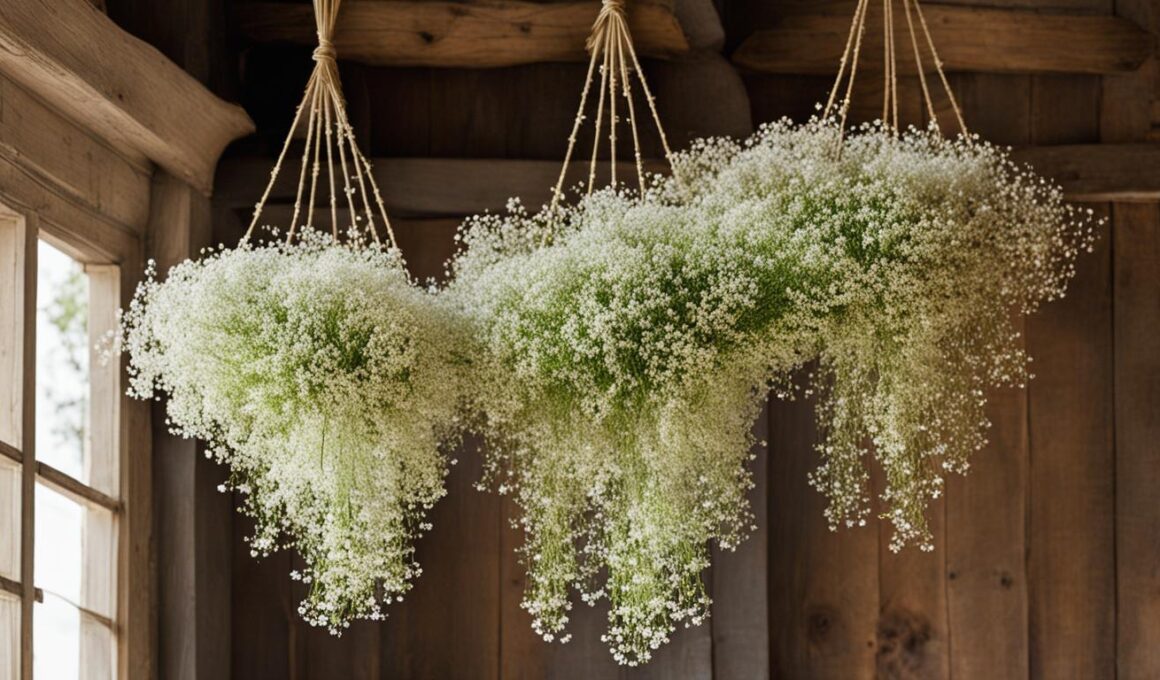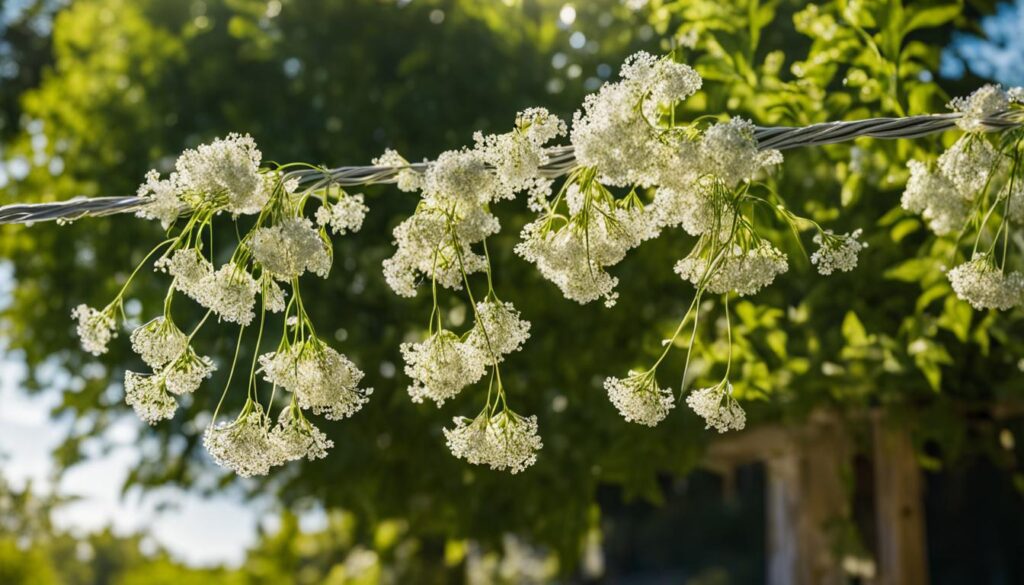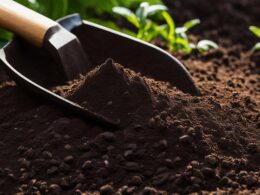Baby’s breath is a delicate and elegant flower often used in floral arrangements. Learning how to properly dry baby’s breath can preserve its delicate beauty and allow you to create long-lasting floral arrangements.
In this section, we will explore the best techniques for drying baby’s breath and preserving its timeless charm. Whether you want to create stunning dried floral arrangements or add a touch of elegance to your crafts, understanding the proper drying techniques is essential.
Preserving the delicate beauty of baby’s breath not only extends its lifespan but also ensures that its charm remains intact. By following the right methods, you can effectively dry baby’s breath and showcase its beauty in a variety of creative ways. From classic flower bouquets to unique décor pieces, dried baby’s breath offers endless possibilities.
Join us as we delve into the world of drying techniques and discover how you can prolong the beauty of baby’s breath for long-lasting floral arrangements and more.
Caring for Baby’s Breath: Ideal Growing Conditions and Care Requirements
To care for baby’s breath and ensure its optimal growth, you need to provide the ideal growing conditions. This includes considering the climate and location, soil type, watering practices, fertilization, as well as regular pruning and grooming.
Climate and Location
Baby’s breath thrives in moderate temperatures and prefers areas with abundant sunlight, although it can tolerate partial shade. It is important to choose a location that provides at least six hours of direct sunlight each day to promote healthy growth and abundant blooms.
Soil
Baby’s breath requires well-draining soil with a neutral to slightly alkaline pH level, preferably between 6.0 and 7.5. Before planting, prepare the soil by incorporating organic matter or compost to improve drainage and ensure nutrient availability. Avoid heavy clay soils that retain excess moisture, as this can lead to root rot and other issues.
Watering
Proper watering is crucial for the well-being of baby’s breath plants. Water thoroughly and deeply, saturating the root zone, but allow the soil to dry slightly between waterings to prevent overwatering. Strike a balance between providing adequate moisture and avoiding waterlogged conditions, as excessive moisture can cause root rot.
Fertilization
Baby’s breath benefits from regular fertilization to support healthy growth and abundant blooms. Apply a balanced, slow-release fertilizer in early spring as new growth begins. Follow the manufacturer’s guidelines for application rates and frequency. Avoid over-fertilization, as it can lead to excessive foliage growth and reduced flower production.
Pruning and Grooming
Regular pruning and grooming help maintain the overall health and aesthetics of baby’s breath plants. Deadhead spent flowers regularly to encourage continuous blooming. Additionally, remove any damaged, diseased, or overcrowded stems to improve air circulation and minimize the risk of pests and diseases.
| Growing Conditions: | Care Requirements: |
|---|---|
| Abundant sunlight or partial shade | Provide at least 6 hours of direct sunlight daily |
| Well-draining soil with a neutral to slightly alkaline pH | Ensure proper drainage and incorporate organic matter into the soil |
| Proper watering | Water thoroughly, allowing the soil to dry slightly between waterings |
| Regular fertilization | Apply a balanced, slow-release fertilizer in early spring |
| Pruning and grooming | Remove spent flowers and damaged stems regularly |
Step-By-Step Care Instructions
To cultivate thriving baby’s breath plants, it is essential to follow step-by-step care instructions. This includes proper planting techniques, watering and moisture control, pest management, and seasonal care.
Planting Techniques
When planting baby’s breath, choose a well-draining location with full sun or partial shade. Dig a hole that is slightly larger than the root ball of the plant. Gently place the plant in the hole and backfill with soil, firmly pressing it down around the base of the plant. Water the newly planted baby’s breath thoroughly to help settle the soil.
Watering and Moisture Control
Consistent watering is crucial for the health of baby’s breath plants. Water the plant consistently, ensuring the soil remains moist but not waterlogged. Baby’s breath prefers slightly dry conditions, so avoid overwatering which can lead to root rot. Mulching around the plant can help retain moisture and protect the roots from temperature fluctuations.
Pest Management
Monitor your baby’s breath plants regularly for common pests such as aphids, spider mites, and whiteflies. These pests can cause damage to the foliage and inhibit the plant’s growth. If you notice any signs of infestation, apply appropriate pest control treatments, such as insecticidal soap or neem oil, following the product instructions carefully.
Seasonal Care
Baby’s breath plants require seasonal care to promote healthy growth and continuous blooming. In early spring, apply a slow-release balanced fertilizer to provide essential nutrients. Prune the plants after the blooming season to remove any dead or damaged stems and promote new growth. Additionally, deadheading the flowers by removing faded blooms can encourage the plant to produce more flowers throughout the season.
Preserving Baby’s Breath’s Beauty
Preserving the delicate beauty of baby’s breath is essential to showcase its charm in long-lasting floral arrangements and crafts. By properly drying baby’s breath, you can maintain its delicate charm and use it in various forms of creative expression, such as dried floral arrangements and crafts.
When it comes to drying techniques, there are several methods you can choose from. Air drying, for instance, involves gathering small bunches of baby’s breath, tying them at the stems, and hanging them upside down in a well-ventilated area. This method allows the flowers to naturally dry while retaining their shape and color.
Once your baby’s breath blooms have dried, proper storage is crucial to preserve their beauty for an extended period. To store dried baby’s breath, place them in airtight containers or resealable bags to protect them from moisture and pesky insects. Keep them in a cool, dry place away from direct sunlight to prevent fading.
With preserved, dried baby’s breath, you can unleash your creativity and showcase its beauty in stunning dried floral arrangements. Combine them with other dried flowers, such as lavender or statice, for a rustic and timeless appeal. They also make exquisite embellishments for wreaths, centerpieces, and DIY crafts, adding a touch of natural elegance to any project.
Can the same method be used to dry baby’s breath as pampas grass?
Yes, the same method can be used to dry baby’s breath as pampas grass. Following specific drying pampas grass tips will help ensure that both baby’s breath and pampas grass maintain their natural beauty and texture during the drying process.










